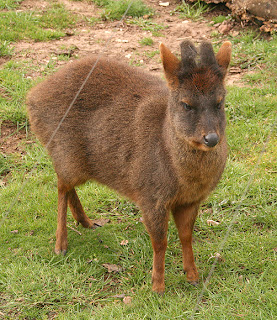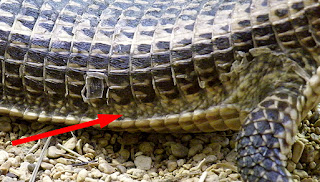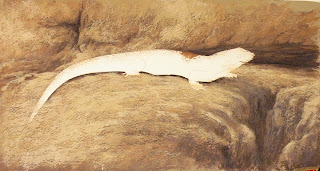Monday 22nd
The morning's check of emails revealed a request from the Herps (reptiles and amphibians) section for a change over of ID on the frog exhibit in Twilight World. Lemur leaf frogs were going to replace the species that had been on show, which I believe were splendid leaf frogs. We had this species on show before so I had the ID sign on file on the computer so it was just a case of printing and laminating the sign and getting to the section so that they could put it up when the frogs went in.
An enquiry last week with the mammal section revealed that the sign explaining why there were wires strung out over one of the animal paddocks, was missing. And despite another search of hard copies in my cabinet and documents on the computer system, the sign could not be found. So starting from scratch again I needed photo's of the wire. These wires are over the South American Paddock where we used to have the black-tailed prairie dogs; but they have gone to another collection and we will shortly have the smaller and daintier European version (the souslik) taking up residence here. The wires are to discourage birds, like pigeons and jackdaws, from taking the food and also, when there are young rodents running around, to stop the gulls predating on them. Whilst taking the photo's, another resident of this paddock, 'Paco'- our male southern pudu, was out and about. His short, but perfectly sharp antlers (as a few keepers would testify when he's tried them out on a human leg) were in velvet, covered in bristly black hair. He watched me taking the photos for a very short time before continuing with the very important job of eating. His mate Jena and their offspring Norman were tucked out of sight inside.
I took the long way back to the studio and en route I saw one of the tapirs having her temperature taken (rectal). The tapirs love being made a fuss of apparently and especially love tummy rubs. One keeper was rubbing the tummy of the tapir whilst she was led down in the enclosure and another was taking her temperature. The keeper's hard work at training the tapirs to have a check up like this, without drugs or restraint, shows in how calm the tapir was... I'm sure she was almost going to sleep.
Back in the studio I uploaded and chose one of the photo's that best showed the wires over the paddock and created a new sign... I just need the text from the animal department now to complete it.
In the afternoon I sorted through my reference photo's of the great plated lizard - Gerrhosaurus major and printed off a selection to work from. An internet search showed images with a number of variations in markings.. I needed to check with the animal section that our lizards had generic markings (i.e. they were the same as any other animal of this species, no markings that were only on those individuals). The chat with Andy, one of the keepers with reptiles, revealed the variations I saw on the internet images were of subspecies difference. Our animals at the zoo have no individual markings although there is one with a regrown tail (many years ago) so when I paint it I need to change that. In my internet searches for references I always try to find several written descriptions from reputable specialist sites like the IUCN, ARKIVE and in this case, specialist reptile sites. The written descriptions can tell me something I hadn't known about or noticed when viewing the live animal. And with these lizards, their bodies are, as the name suggests, covered with plates giving them protection in the form or 'armour plating'. However, one description mentioned a gap between the plates down the side of the body; this area of skin allowed the animal to expand, whereas a complete covering of plates wouldn't... handy if you have eaten too much. I had not noticed it on my reference photo's, so I went across to the reptile house for another look at our two animals on show and took some more photo's of this feature.
The lizard is long bodied with a long tail, so if I illustrated it with the tail straight out behind, the illustration would end up quite small to fit the whole animal into the space I had to work with. So when I did the drawing, I drew the tail curved round allowing the animal to be bigger on the sign.
I'm getting quite good at remembering to take my camera with me when I go out and about around the zoo... here are some of the photo's I took.
Kemran and Ketan are growing fast... they are now looking more like scruffy juveniles than 'cute soft fluffy' cubs. Their bodies have lengthened proportionately and the fur around the neck is starting to lengthen too.
One of the new baby primates born recently... a Goeldi's monkey. This was taken with a fine wire mesh between us which is why there are those strange light patches over the darker areas of fur.
Tuesday 23rd
I transferred the drawing of the lizard onto a 330mm x175mm piece of 300grms watercolour paper. The lizard comes from rocky deserts in Africa, so the background I chose to do would be rock. This is a simple backdrop and here is a step by step of how I achieved the rock texture.
I start with a neutral stone grey and then using dry brush strokes apply a muddy purple colour over it. I can't be precise with the colours as I have made them up out of numerous colours over the years.
I have an idea of the formation of the rock I'd like to achieve, so as I apply the paint, in each successive layer, I am aiming towards that. But I allow myself the option, if the scumbling effects create a different form of the rock surface, to change.
I am basically going loosely from dark to light, so the colours are added only in a sequence that suits that. The colours I am applying are mixes I have had in my palette for years as basics that I use over and over again, always adding to and changing slightly each time. This approach suits me in that paint wastage is minimal and I get palettes of colour ranges of browns and greens, beiges and blues that I can use for pretty much anything over and over again. This layer had a warm ochrey brown.
Then in with a darker brown.. the form of the rock is starting to emerge and evolve... the dark area behind the head is to 'throw the head out' - make it stand out against the similar colours the rock will be.
Next I start taking the light tones up a notch.
Adding warm colours in, to counter the cooler colours of the purple tone.
More light tones, defining the shadow from the front of the lizard and some detailing around the rock crevices.
Lighter still...
Final layer of light tone sets the formation. Happy with that I leave it.
Here is a close up of the dry brush work effect.
During the morning I had popped out to try and get a better photo of the wires in bright sunshine... yesterday was cloudy, today is glorious Spring. The sky was beautifully blue and clear and the cherry blossoms looked stunning.
I also saw a female mallard with ducklings, nothing unusual in that at this time of year, but what did strike me as unusual was the male that was in their company. This is the second time I have seen a male (could be the same one) sticking close to a female and ducklings this year. I have never seen this behaviour in the male mallards at the zoo before... so I am intrigued by this.
In the afternoon I was ready to start on the lizard itself... this is when the trouble started!
I put the base coat on the lizard shape and started 'mapping'in the vertical grid lines for the plates. As this lizard has a precise pattern to the scales I had to get it right on my illustration and I can't begin to tell you the problems I had, for some reason, to do the what looked like a 'simple' task of painting in those few lines. I mean... how hard can it be!? Surely this is straightforward.
It grieves me greatly that it took me ALL afternoon...four hours to get the spacing, number of lines and curve right over the body and tail... I had to paint them in and out numerous times (waiting for paint to dry inbetween) before I was happy that I got the grid right. It didn't help that my new 'short-range' glasses are at the opticians to have the lens' adjusted so I can get closer to the work for such fiddly stuff. By the end of the afternoon I felt mentally exhausted from the close work and concentration, had back ache from leaning over the desk more and more tensely and a head ache to cap it all. I couldn't wait to get out of the studio and leave it alone.
Wednesday 24th
Came in eager to get on with the fun bit of painting the lizard's plates on... I was planning on this being finished by 5pm. It would have been my sketch afternoon today but I really wanted this lizard done and finished, so I decided to postpone that until next week. I should have stuck with Plan A.
So the battle with me and the lizard commenced! And what a battle! There was me thinking just painting in the grid was bad enough.... the plates were a nightmare! I was working on a scale that was really too small for my eyesight to see easily where the tip of my '0' brush was going. But that is nothing new, I have been doing that for a while... my new glasses should help solve that problem. I can't paint the beast bigger as it has to fit onto an A4 scanner. I took the plates one horizontal line at a time... , the grid was good but the fiddle was getting the patternation of the plates right.. this is what makes the lizard look like it does.. if I just made up the pattern it would be easier but then it wouldn't be species specific. It was easy to lose my 'place' in the pattern and on which plate I was working from and on! I got in a base of pattern and then went back to detail it, which is where most of the problem lay. My eyes kept 'blurring out' as I tried to follow the pattern from the references and the recreate that on my illustration. It was like trying to concentrate on and dismantle visually, an optical illusion! Made me go 'goggled eyed'.
I kept at it, refusing to back down all morning and into the afternoon. After numerous repaints, adjustments and fiddly bits I had got the body done and was starting the tail... Maybe it was because my eyes were tired, my back aching again and my brain numbed by the concentration all day but I just could not get the plates to 'sit' right. At the top of the tail the numerous lines of plates merge down to fewer lines on the tail, so there is a definite pattern to the way the plates merge... this was where I was rapidly losing all sense of sanity. I gave up at 3.30pm. Had to walk away from it before I ripped the illustration up or threw it out of the window! Artistic temperament rearing it's ugly head... If you still think painting is relaxing, try doing this guy as accurately as you can.
I was not in a good mood or frame of mind so I thought I needed a walk in the fresh air to see lovely things to get my mood back to being pleasant again... and a chocolaty treat from one of the vending machines around the zoo grounds, would also help enormously. It was a lovely walk, the sun was still out and there were gorgeous camelias in bloom, the daffs at the front of the reptile house were looking splendid. I watched spiny mice in Twilight World investigating the leaves and twigs that the keepers put in recently for them. I saw the pygmy slow loris moving around, there is a baby but I think the adult carrying it was hidden at the back of the enclosure. I had a lovely walk and eventually stopped fuming so much and was able to start thinking of how I was going to proceed for the rest of the day. I couldn't go back to the lizard... that would not be productive.... so I thought about the next species to do... another lizard. I could start the drawing for that at least and go from there.
Back in the studio the next lizard on my list is a blue spiny lizard... I looked at the ref pix I had and decided maybe this wasn't the one to do next... it also had a precise scale/plate pattern and I just could not face that right now. So the next on the list is a panther chameleon - Furcifer pardalis. I has a pattern but due to the nature of the beast, I can be a little freer with it. Not so precise or restrictive... just what I need for the next job.
I went through my selection of reference photo's for this species, studied them all and made the decision as I looked through them how best to portray the animal position-wise. I collated the images that would help me achieve that illustration and printed them off. Then I sat and relaxed into the drawing/sketch of the chameleon for the last hour. This was a good way to end the day... The fight with the plated lizard will continue next week!




















No comments:
Post a Comment